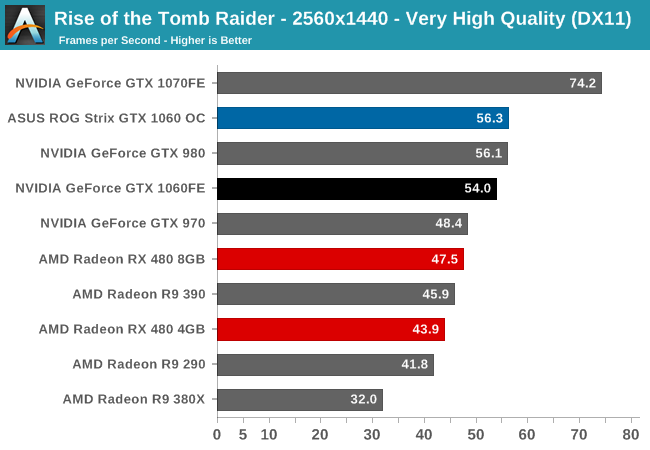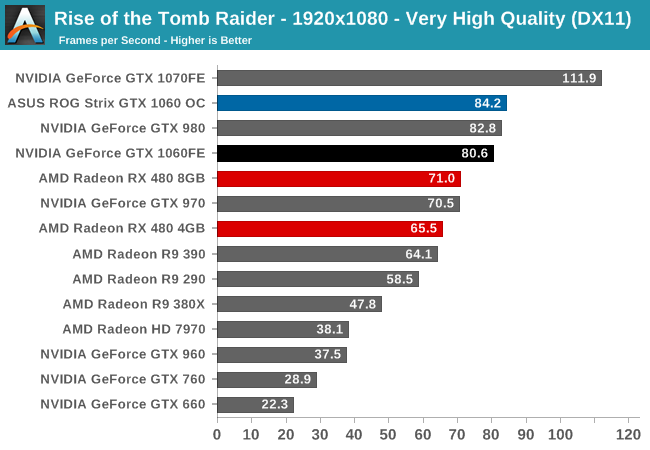The GeForce GTX 1060 Founders Edition & ASUS Strix GTX 1060 Review
by Ryan Smith on August 5, 2016 2:00 PM ESTRise of the Tomb Raider
Starting things off in our benchmark suite is the built-in benchmark for Rise of the Tomb Raider, the latest iteration in the long-running action-adventure gaming series. One of the unique aspects of this benchmark is that it’s actually the average of 4 sub-benchmarks that fly through different environments, which keeps the benchmark from being too weighted towards a GPU’s performance characteristics under any one scene.


NVIDIA promised GTX 980-like performance for the GTX 1060, and this is more or less where they’ve landed under Tomb Raider. The otherwise stock clocked GTX 1060FE underperforms GTX 980 by only a frame or two, delivering about 97% of the performance, while the factory overclocked ASUS card makes up the difference and takes the lead. Or to compare things to the next tier up, GTX 1060 is delivering about 72% of GTX 1070’s performance for about 65% of the price.
Meanwhile the performance gains over the past generation GTX x60 cards are remarkable. Whereas GTX 960 struggled to break out of the 30s on framerate, GTX 1060 just cracks 80fps. This is 215% of GTX 960’s performance, more than doubling its predecessor. Some of this I don’t doubt comes down to memory – our GTX 960 is the more common 2GB variety – but it also goes to show once again how 2GB cards are now VRAM limited under modern games. And the performance gains are even greater if we go back to 2013’s GTX 760 or 2012’s GTX 660. GTX 960’s one disappointment was that it didn’t make as much progress over GTX 760 as everyone would like, but GTX 1060 more than makes up for this.
As for the AMD competition, things shape up about as you’d expect. In our look at RX 480 we found that it delivered GTX 970-like performance, while GTX 1060 is slated to deliver GTX 980-like performance. As a result we see the GTX 1060 lead by around 15% at both resolutions for Tomb Raider.










189 Comments
View All Comments
Ryan Smith - Friday, August 5, 2016 - link
Since there is no standard benchmark, it depends on the area you use. We purposely picked a section of the game that would be among the most demanding.Arbie - Friday, August 5, 2016 - link
I really want to 'need' a new graphics board for FPS gaming. But I can't find any such games worth playing that need one. They're all console ports with mediocre graphics and even worse mechanics. And my GTX 770 is more than enough even on 2560x1440. I still read about the new cards but... how long...Simplex - Sunday, August 7, 2016 - link
"And my GTX 770 is more than enough even on 2560x1440"So you play at sub-30 fps and/or low details?
Arbie - Sunday, August 7, 2016 - link
Simplex - Can't see how you jumped to that conclusion, so I guess you're just trying to be contentious. FOR THE GAMES I *DO* PLAY the 770 is fine. That's my point, and the reason I personally am not in the market.I don't check frames per sec unless the gameplay is laggy. When it is - which is rare with the 770 - I dial down the eye-candy. Beyond a certain point that doesn't matter anyway, compared to game design & mechanics. The problem is that there are NO NEW FPS GAMES that deliver on those two aspects. My benchmark game is Crysis (and its siblings) which I run at "Very High" settings. There are a few games now with equally good graphics, but nothing even compares for fluidity, control, physics, level design, AI quality etc etc. Until there is, I won't need a new card. I wish it were otherwise.
just4U - Friday, August 5, 2016 - link
A note for Nvidia since they will likely read these comments (..as will AMD)I've said there is a market for a reference design using a stylish reference cooler (like what you see on the Titan series..) For some it's worth the $50 admission. If your going to do that at the lower end but charge a premium... make sure it's got the same goodness as the upper end models.
Your 1060 Founders might sell.. but it won't sell as well as it could have if you'd gone all out on the cooler like you have for the higher end models. Plastic? Ugh.. No full backplate? Please.. Come on!
AnnonymousCoward - Friday, August 5, 2016 - link
Now that you mention it, I've got a note for NVIDIA too: support the VESA standard Adaptive-Sync already! My monitor supports it, why won't you.Gigaplex - Monday, August 8, 2016 - link
If they do that, then there would be no reason for manufacturers to produce G-SYNC monitors. They'd all flock to Freesync compliance.Beararam - Friday, August 5, 2016 - link
Great review, Ryan. Hope all the negative comments don't bring you down. Probably a lot going on behind the scenes that we don't see.VulkanMan - Friday, August 5, 2016 - link
Why no encoding tests?Both camps support H.265 HEVC encoding & decoding.
Ryan Smith - Saturday, August 6, 2016 - link
I've looked into it, but I haven't found any good encoding tests right now, particularly those that use HEVC. But if you happen to come across something, then I'm all ears.=)